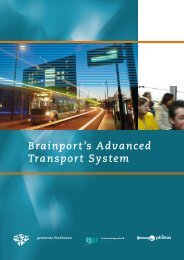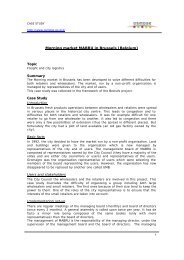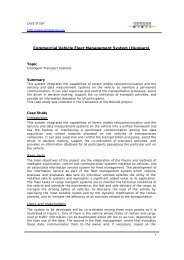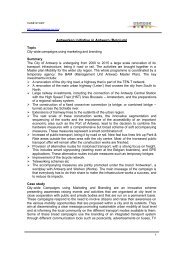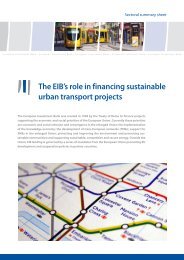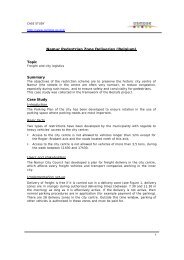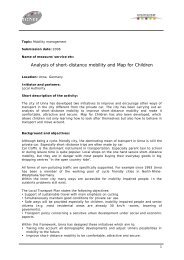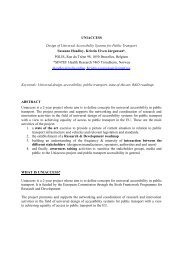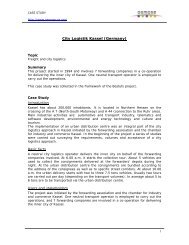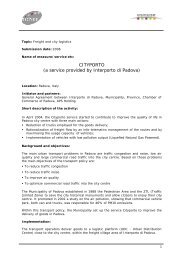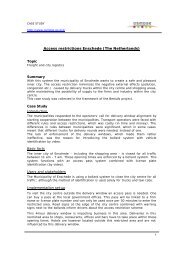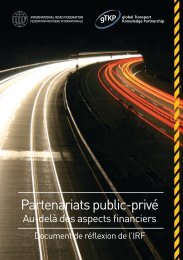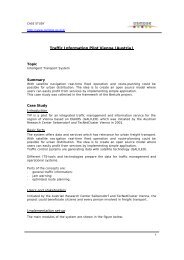Copenhagen_city access.pdf - Osmose
Copenhagen_city access.pdf - Osmose
Copenhagen_city access.pdf - Osmose
Create successful ePaper yourself
Turn your PDF publications into a flip-book with our unique Google optimized e-Paper software.
CASE STUDY<br />
http://www.osmose-os.org/<br />
City Distribution in <strong>Copenhagen</strong> (Denmark)<br />
Topic<br />
Freight and <strong>city</strong> logistics<br />
Summary<br />
The City Centre in <strong>Copenhagen</strong> has an inner area with a road net from medieval<br />
time. It is about 1 km x 1 km. Around 6.000 lorries and trucks daily have got their<br />
origin or destination within the <strong>city</strong> centre. The main objective of the City Distribution<br />
Project was to increase the use of capa<strong>city</strong> in the lorries and vans entering the <strong>city</strong><br />
centre.<br />
This case study was collected in the framework of the Bestufs project.<br />
Case Study<br />
Introduction<br />
The project was initiated by the Mobility and Parking Directorate in order to tackle<br />
the increasing problems due to freight transport within the <strong>city</strong> centre.<br />
Basic facts<br />
The main objective for the whole projects was to increase the use of capa<strong>city</strong> in the<br />
lorries and vans entering the <strong>city</strong> centre. The philosophy behind is that the State and<br />
the Municipalities cannot establish a sustainable urban freight transport, but they can<br />
“make it easier” for the carriers to choose a sustainable solution.<br />
Users and stakeholders<br />
In order to work on the problems caused by freight transport and especially a low<br />
capa<strong>city</strong> utilization, a working group on goods freight in the inner <strong>city</strong> was founded.<br />
This working group consists of representatives from: Danish Rail, Danish Mail,<br />
Danish Transport and Logistic Association (Danish hauliers organisation), Danish<br />
Freight Association, Carlsberg brewery, Dairy company MD-Foods, retail store shops,<br />
<strong>Copenhagen</strong> City Centre Association, Business University of <strong>Copenhagen</strong> and<br />
<strong>Copenhagen</strong> Road Department.<br />
Implementation set-up<br />
The carriers commit themselves to:<br />
• Use the capa<strong>city</strong> of every single vehicle to an average of 60% over a 3-month<br />
period.<br />
• Sign up all the vehicles between 2-18 tons driving to/from the area.<br />
• Only use vehicles with engines younger than 8 years.<br />
• Send once every 3 months a report of the capa<strong>city</strong> use.<br />
1
CASE STUDY<br />
http://www.osmose-os.org/<br />
As participation in the scheme it some accompanying measures were implemented<br />
on a voluntary basis in order to encourage the companies to join in the project:<br />
• 10 loading zones were established, exclusively reserved for the participants to<br />
load/unload goods on weekdays between 8-12 h.<br />
• The companies will be entitled (by streamers etc.) to show and promote that they<br />
are participating in an environment improving scheme.<br />
• The list of the companies involved was published on the “City Distribution”<br />
website on the Internet, so that the customers could choose a “green” carrier.<br />
• Possibility to influence a later obligatory scheme.<br />
The control is being performed on the basis of the report send to the Road<br />
Department for each vehicle. The parking guards check if only vehicles with a<br />
certificate (sticker) in the windows hold in the loading zone between 8 and 12. All<br />
other vehicles are being fined. At the same time the guards observe the vehicles in<br />
the certificate area so that the administration can crosscheck with the information<br />
given by the companies about the capa<strong>city</strong> use.<br />
Results<br />
After a year and a half the experiment ended in an agreement with the carriers in<br />
the end of February 2000. 80 companies have registered more than 300 vehicles to<br />
the scheme. Several of these vehicles were entering the <strong>city</strong> centre several times a<br />
day. The bigger vehicles were dominating the experiment. Of the total number of<br />
trucks and vans to the inner <strong>city</strong>, 88 % is between 2 and 3½ tons.<br />
Almost all of the participants in the voluntary scheme were reportedly able to use<br />
60% of the capa<strong>city</strong>. There were some problems with certain kind of transport (e.g.<br />
chilled goods).<br />
The carriers were in general satisfied with the scheme. For the majority it took less<br />
than 10 minutes to fill in the apply form and the quarterly reports. 86% of the<br />
participants would like to have an obligatory arrangement.<br />
20% of the carriers have changed their daily transport planning behaviour during the<br />
experiment.<br />
Also more <strong>city</strong> logistic collaboration between the carriers has appeared during the<br />
experiment, naturally also for several other reasons.<br />
The ministry of Transport explained in spring 1999 that it was against the law to<br />
reserve loading zones for cars with certificate. They should be open for all trucks. At<br />
the same time the ministry promised that they would prepare a new paragraph in<br />
the law, making it possible for municipalities to make experiments.<br />
This new paragraph was presented for the Parliament in November 1999 and they<br />
agreed late April 2000. In March the Town Council has decided that a new proposal is<br />
needed for an obligatory arrangement when the new law for experiments was ready.<br />
2
CASE STUDY<br />
http://www.osmose-os.org/<br />
Future prospects and conclusions<br />
Within an obligatory scheme the following regulations and exceptions will be<br />
included:<br />
• It will either not be allowed to enter or to stop in the inner <strong>city</strong> for lorries and vans<br />
over 2 tons.<br />
• To reserve 40 loading zones reserved for vehicles with a “green” certificate, cars<br />
there use 60% of their capa<strong>city</strong> in average over 3 months.<br />
• “Red” (one day) and “Yellow” (transitional phase) certificate for special cases.<br />
• Different fee for the different certificates.<br />
• Fines for trucks and vans which are parking within the zones without certificate<br />
(about 100 Dmk).<br />
• Vehicles as emergency or vehicles, more tools than vehicles as lifts, garbage<br />
collection etc. will not be included.<br />
The following problem in an obligatory scheme has still to be solved: Some types of<br />
transports cannot fulfil the demand of 60% use of capa<strong>city</strong>. It is expected that the<br />
obligatory scheme will lead to a reduction of the number of lorries and trucks<br />
entering the <strong>city</strong> centre (about 30%). This would lead to a reduction of emissions<br />
(particles: 25%, NO2: 5%. and NOx: 10%).<br />
Web links<br />
http://www.bestufs.net/<br />
Author contact details<br />
Author who did the material collection for BESTUFS:<br />
Mr. Soren B. Jensen<br />
E-mail: Sojen@btf.kk.dk<br />
City or region<br />
<strong>Copenhagen</strong><br />
Country<br />
Denmark<br />
Submission date<br />
2000<br />
3



